Interactive Television
Gesture-Aware Remote Controls: Guidelines and Interaction Techniques (ICMI'11)
Interaction with TV sets, set-top boxes or media centers strongly differs from interaction with personal computers: not only does a typical remote control suffer strong form factor limitations but the user may well be slouching in a sofa. In the face of more and more data, features, and services made available on interactive televisions, we propose to exploit the new capabilities provided by gesture-aware remote controls. We report the data of three user studies that suggest some guidelines for the design of a gestural vocabulary and we propose five novel interaction techniques.
Study 1 reports that users spontaneously perform pitch and yaw gestures as the first modality when interacting with a remote control.
Study 2 indicates that users can accurately select up to 5 items with eyes-free roll gestures.
Capitalizing on our findings, we designed five interaction techniques that use either device motion, or button-based interaction, or both. They all favor the transition from novice to expert usage for selecting favorites. Study 3 experimentally compares these techniques. It reveals that motion of the device in 3D space, associated with finger presses at the surface of the device, is achievable, fast and accurate. Finally, we discuss the integration of these techniques into a coherent multimedia menu system.
Study 1 reports that users spontaneously perform pitch and yaw gestures as the first modality when interacting with a remote control.
Study 2 indicates that users can accurately select up to 5 items with eyes-free roll gestures.
Capitalizing on our findings, we designed five interaction techniques that use either device motion, or button-based interaction, or both. They all favor the transition from novice to expert usage for selecting favorites. Study 3 experimentally compares these techniques. It reveals that motion of the device in 3D space, associated with finger presses at the surface of the device, is achievable, fast and accurate. Finally, we discuss the integration of these techniques into a coherent multimedia menu system.
| Sofa interaction | 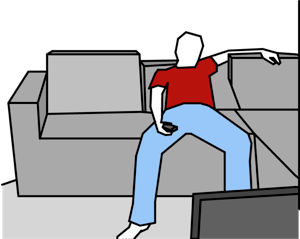 |
| Augmenting a remote control with mid-air gestures allowing 6 degrees of freedom | 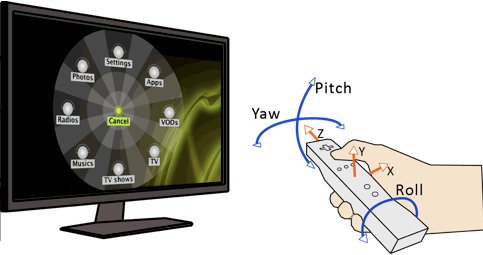 |
| Novice mode: selection of favorites |  |
| Yaw gestures for navigating in a table |  |
| Investigating roll gestures: Left: a preparatory back- roll for increasing the total roll movement. Right: Execution of the roll gesture (the trigger being kept pressed) |  |
| Design space for a two-level menu. Techniques that appear over a white background are evaluated | 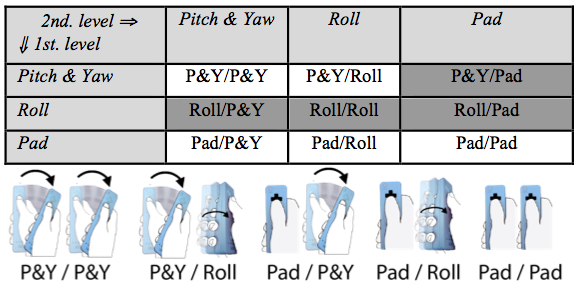 |
| Mean selection time for each technique with 95% confidence interval marked | 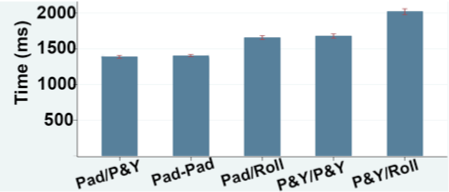 |
| Mean accuracy rate (% correct) for each technique | 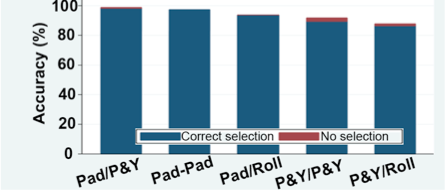 |
Taxonomy of remote controls in the context of Interactive television (IHM'11)
Initially designed in the ninetten seventies as a mere zapping tool, obviously the traditional device known as the TV remote control no longer responds to the multifarious needs of today's interactie television. Designing new remote-control devices is a challenge that the HCI community has started to face. The paper indicates the various directions that are currently being investigated by researchers. The paper starts with an attempt to characterize the specific context of interactive TV. We then offer tentative account of the design and evaluation space of interest. There is little doubt that the traditional remote control may still be improved and augmented. It is unlikely, however, that it will survive for long the crisis it has been undergoing since the beginning of the digital era, give the emerging plethora of alternative interaction possibilities based on a variety of new interfacing logics, which the paper reviews.
Comparing Free Hand Menu Techniques for Distant Displays using Linear, Marking and Finger-Count Menus (INTERACT 11)
Distant displays such as interactive Public Displays (IPD) or Interactive Television (ITV) require new interaction techniques as traditional input devices may be limited or missing in these contexts. Free hand interaction, as sensed with computer vision techniques, presents a promising interaction technique. This paper presents the adaptation of three menu techniques for free hand interaction: Linear menu, Marking menu and Finger-Count menu.
The first study based on a Wizard-of-OZ protocol focuses on Finger-Counting postures in front of interactive television and public displays. It reveals that participants do choose the most efficient gestures neither before nor after the experiment. Results are used to develop a Finger-Count recognizer. The second experiment shows that all techniques achieve satisfactory accuracy. It also shows that Finger-Count requires more mental demand than other techniques.
The first study based on a Wizard-of-OZ protocol focuses on Finger-Counting postures in front of interactive television and public displays. It reveals that participants do choose the most efficient gestures neither before nor after the experiment. Results are used to develop a Finger-Count recognizer. The second experiment shows that all techniques achieve satisfactory accuracy. It also shows that Finger-Count requires more mental demand than other techniques.
| Touch-Less Finger-Count for Distant Displays |  |
| Application on interactive television | 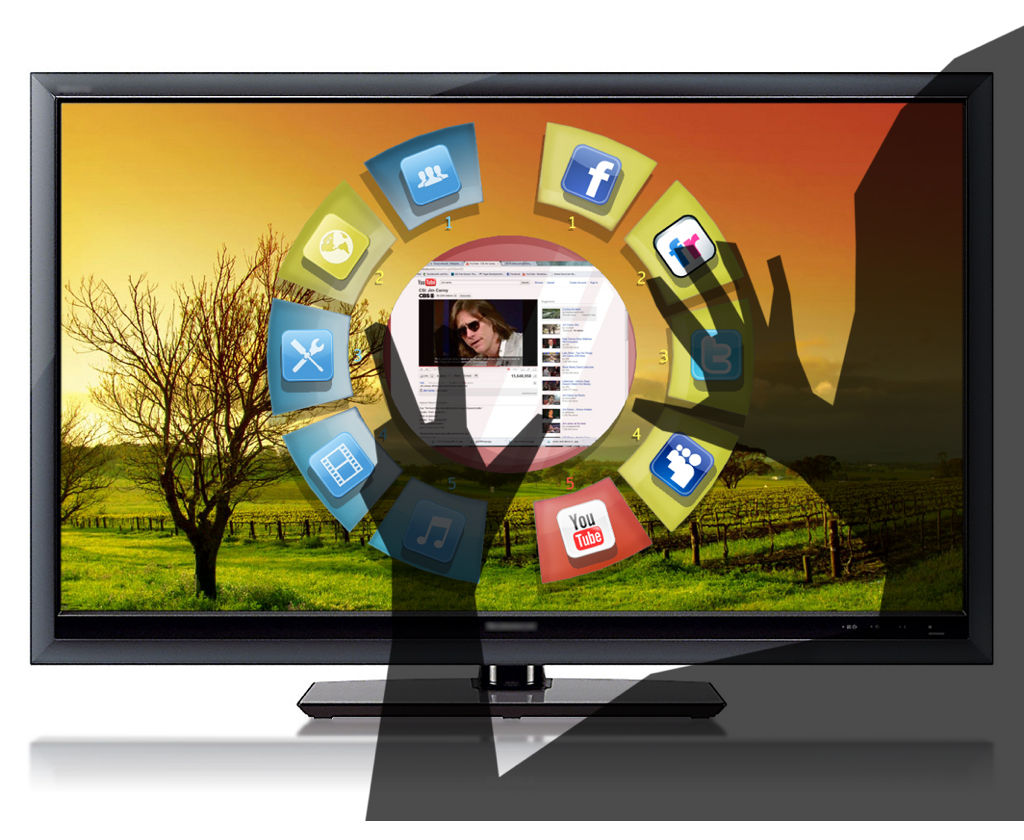 |
References
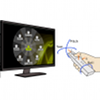 |
Gilles Bailly, Dong-Bach Vo, Eric Lecolinet, Yves Guiard Gesture-Aware Remote Controls: Guidelines and Interaction Techniques ACM ICMI'11, pages XX. |
 |
Dong-Bach Vo, Gilles Bailly, Eric Lecolinet, Yves Guiard Un espace de caracterisation de la telecommande dans le contexte de la television interactive ACM IHM'11, short paper. |
 |
Gilles Bailly, Robert Walter, Joerg Muller, Tongyan Ning and Eric Lecolinet Comparing Free Hand Menu Techniques for Distant Displays using Linear, Marking and Finger-Count Menus. IFIP INTERACT'11, pages XX. |
Related Projects
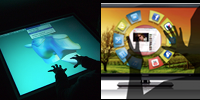 Finger-Count |